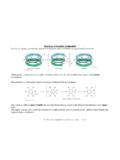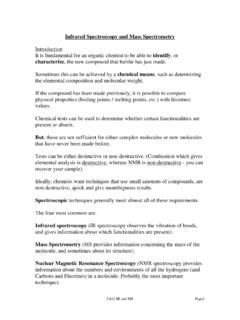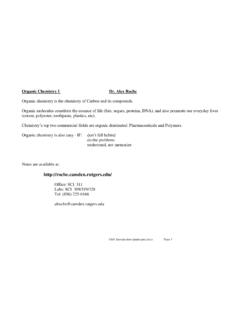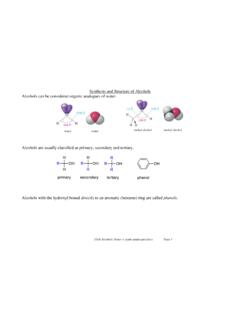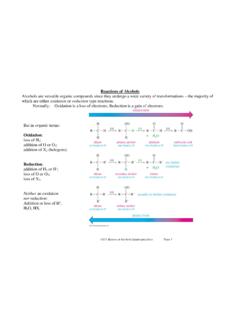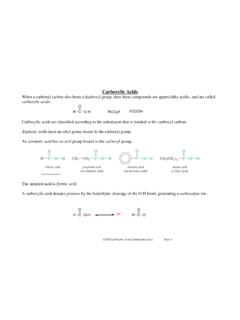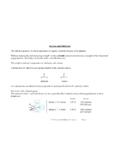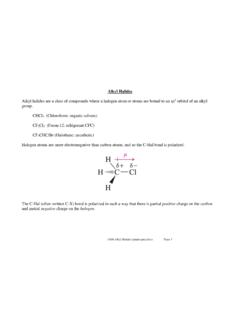Transcription of Organic Chemistry I - Rutgers University
1 Ch01 Introduction (landscape).docx Page 1 Organic Chemistry I Dr. Alex Roche Organic Chemistry is the Chemistry of Carbon and its compounds. Organic molecules constitute the essence of life (fats, sugars, proteins, DNA), and also permeate our everyday lives (cotton, polyester, toothpaste, plastics, etc). Chemistry s top two commercial fields are Organic dominated: Pharmaceuticals and Polymers. Organic Chemistry is also easy - IF: don t fall behind do the problems understand, not memorize Notes are available at: Office: SCI 311 Labs: SCI 309/319/328 Tel: (856) 225-6166 Ch01 Introduction (landscape).
2 Docx Page 2 Structure of the Atom Atoms consist of: Protons (+ve) Neutrons (neutral) Electrons (-ve) Protons and neutrons are in the nucleus and have similar masses (1800x that of an electron). Atoms with the same number of protons but different neutrons are called ISOTOPES. 12C (major isotope) 13C (~1%, used in carbon NMR) 14C (radioactive, used in Carbon dating) Almost all the mass of an atom is in the nucleus, but it is the electrons that are involved in the chemical bonding and reactions of an atom.
3 Electronic Structure of the Atom Electrons display wave-particle duality. Electrons are located in orbitals around a nucleus, but the Heisenberg Uncertainty Principle tells us that we cannot pinpoint exactly where the electron is. So we use the term ELECTRON DENSITY, which is the probability of finding the electron in a particular part of the orbital. ORBITAL: is an allowed energy state for an electron, with an associated probability function that defines the distribution of electron density in space. Ch01 Introduction (landscape).
4 Docx Page 3 Atomic Orbitals These are different shells at differing distances away from the nucleus. Each has a principal quantum number (n). As n increases, Shells are further from the nucleus Higher energy Can hold more electrons n=1 can hold 2 electrons, n=2 can hold 8 electrons. Ch01 Introduction (landscape).docx Page 4 First Electron Shell Contains the 1s orbital. An s orbital is spherical, so the electron density is only a function of the distance from the nucleus. Ch01 Introduction (landscape).
5 Docx Page 5 Second Electron Shell Contains the 2s and the 2p orbitals. 2s is also spherically symmetrical, but is not a simple exponential function. Most of the electron density is further away, past a NODE (region of zero electron density). Ch01 Introduction (landscape).docx Page 6 The second shell also contains three 2p atomic orbitals. These are oriented in the three spatial directions. (2px, 2py, 2pz). Orbitals of the same energy are said to be DEGENERATE. Ch01 Introduction (landscape).docx Page 7 2p orbitals are slightly higher in energy than 2s orbitals because the average location of the electron is further from the nucleus.
6 The Pauli Exclusion Principle tells us each orbital can hold a maximum of 2 electrons, provided the spins are paired. The first shell (one 1s orbital) can hold 2 electrons. The second shell (one 2s and three 2p orbitals) can hold 8 electrons. The third shell (one 3s, three 3p and five 3d orbitals) can hold 18 electrons. Ch01 Introduction (landscape).docx Page 8 Electronic Configuration of Atoms The Aufbau Principle tells us how to build up a ground state (most stable) configuration, which is to fill the orbitals in order, until the correct number of electrons has been added.
7 Hund s rule states that when there are two or more degenerate orbitals available, electrons would rather go into different orbitals rather than the same one. Element Configuration Valence Electrons H 1s1 1 He 1s2 2 Li 1s2 2s1 1 Be 1s2 2s2 2 B 1s2 2s2 2px1 3 C 1s2 2s2 2px1 2py1 4 N 1s2 2s2 2px1 2py1 2pz1 5 O 1s2 2s2 2px2 2py1 2pz1 6 F 1s2 2s2 2px2 2py2 2pz1 7 Ne 1s2 2s2 2px2 2py2 2pz2 8 The valence electrons are those in the outermost shell. (Periodic group number is the number of valence electrons).
8 Bonding Atoms transfer or share electrons in such a way as to attain a filled shell of electrons The OCTET rule. A filled shell is also known as a noble gas configuration. Ch01 Introduction (landscape).docx Page 9 Ionic Bonding The transfer of one or more electrons from one atom to another. Covalent Bonding The electrons are shared, not transferred. Covalent is the most important bonding in Organic Chemistry . Ch01 Introduction (landscape).docx Page 10 Lewis Structures Each electron is represented by a dot.
9 A pair of electrons by two dots, or a dash. Each carbon is surrounded by 8 electrons Each hydrogen is surrounded by 2 electrons. Ch01 Introduction (landscape).docx Page 11 Nonbonding pairs of electrons Also known as lone pairs. Lone pairs often dictate a molecule s reactivity. Multiple Bonds The sharing of one pair of electrons is a single bond. The sharing of two pairs gives a double bond. Ch01 Introduction (landscape).docx Page 12 The sharing of three pairs gives a triple bond. In neutral Organic compounds: Carbon forms four bonds Nitrogen forms three bonds (and a lone pair) Oxygen forms two bonds (2 lone pairs) Hydrogen forms 1 bond.
10 The number of bonds an atom normally forms is called the VALENCY. Nitrogen is trivalent. Ch01 Introduction (landscape).docx Page 13 Bond Polarity A covalent bond, where the electrons are shared equally is called a non-polar bond. ( H-H) Bonds between different atoms usually result in the electrons being attracted to one atom more strongly than the other. Such an unequal sharing of the pair of bonding electrons results in a POLAR bond. This competition for electron density is scaled by ELECTRONEGATIVITY values.
